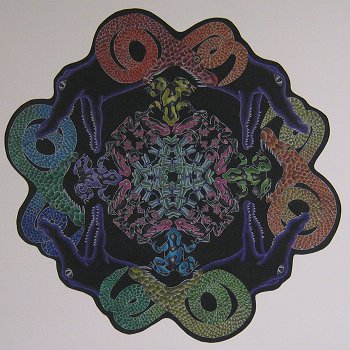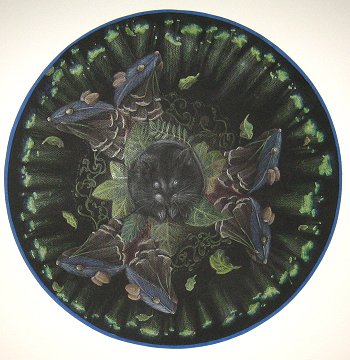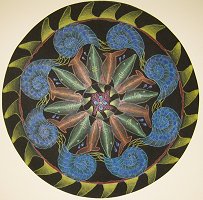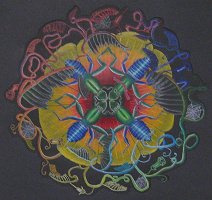- By Dan Veaner
- Around Town
 Print
Print
Lansing Community Library Center hosted a reception for the 'Mandalas: Radial Imagery' exhibit currently running there through October 22. Mandalas are ritualistic geometric designs used in Buddhism and Hinduism to aid meditation, but creating them offered many lessons to the 9th grade artists. "The thing I like about them is that they are all from exactly the same assignment with a very specific rubric," says Lansing High Scool art teacher Robin Rogers. "But each one is so completely different in the way they did their design work and the subject matter that they picked, and how they handled the materials."

 Rogers (left) with Kate SchuttenbergRogers has been assigning mandalas for all eight years she has taught art in Lansing. The exhibit spans that time, including a mandala by Nate Boles, one of Roger's first students here. Rogers' students start with black paper, drawing their design, including shading, in white pencil. The colors are then layered on, giving the mandala a kind of radiant glow.
Rogers (left) with Kate SchuttenbergRogers has been assigning mandalas for all eight years she has taught art in Lansing. The exhibit spans that time, including a mandala by Nate Boles, one of Roger's first students here. Rogers' students start with black paper, drawing their design, including shading, in white pencil. The colors are then layered on, giving the mandala a kind of radiant glow.
"They start by learning some of the mathematics of how to divide a circle into radial designs and patterns," Rogers explains. "They study the mandalas of the Tibetan Buddhist monks. Then they learn techniques about shading, adding value, which is light and dark to the imagery. Then they pick their subject matter from nature and apply the techniques they have learned with colored pencil."
The basic layout of a mandals mimics the floor plan of Tibetan monasteries, and the designs are intricate. A mandala by Matt Hardesty featured sea creatures, while Sam Gorman's depicts an insect dance. Anna Mapes' 'Food Chain' starts with snakes and alligators around the perimeter about to eat frogs in an inner ring, who are about to eat insects in the center. The detailed drawings almost jump off of the page.
Rogers takes her students to the Johnson Museum to watch Buddhist monks from the Namgyal Monastary on Aurora Street in Ithaca create mandals. The monastery was created to assist Western students who want to study Buddhism, but are not able to spend the time necessary in India. Rogers says the monks work painstakingly on their mandalas, and that kind of care is evident in her students' work.

The exhibit room attracted a small crowd of artists, their families, and others. Many were framed by families who loaned them for the exhibit. Refreshments and music were provided, but the focus was on the art, which was quite varied and, without exception, beautifully rendered.
----
v3i40

'Food Chain,' by Anna Mapes
 Rogers (left) with Kate Schuttenberg
Rogers (left) with Kate SchuttenbergRobin Rogers (left) with Kate Schuttenberg
"They start by learning some of the mathematics of how to divide a circle into radial designs and patterns," Rogers explains. "They study the mandalas of the Tibetan Buddhist monks. Then they learn techniques about shading, adding value, which is light and dark to the imagery. Then they pick their subject matter from nature and apply the techniques they have learned with colored pencil."
 Matt Hardesty's 'Under the Sea' |  Sam Gorman's 'Insect Dance' |
The basic layout of a mandals mimics the floor plan of Tibetan monasteries, and the designs are intricate. A mandala by Matt Hardesty featured sea creatures, while Sam Gorman's depicts an insect dance. Anna Mapes' 'Food Chain' starts with snakes and alligators around the perimeter about to eat frogs in an inner ring, who are about to eat insects in the center. The detailed drawings almost jump off of the page.
Rogers takes her students to the Johnson Museum to watch Buddhist monks from the Namgyal Monastary on Aurora Street in Ithaca create mandals. The monastery was created to assist Western students who want to study Buddhism, but are not able to spend the time necessary in India. Rogers says the monks work painstakingly on their mandalas, and that kind of care is evident in her students' work.

'Pine Cone Mice' by Robin Parkins
The exhibit room attracted a small crowd of artists, their families, and others. Many were framed by families who loaned them for the exhibit. Refreshments and music were provided, but the focus was on the art, which was quite varied and, without exception, beautifully rendered.
----
v3i40



